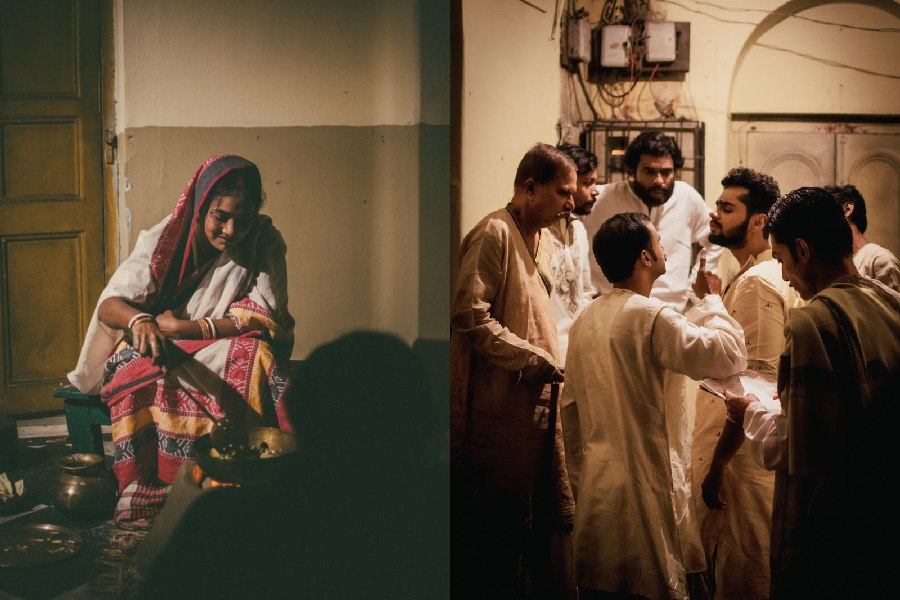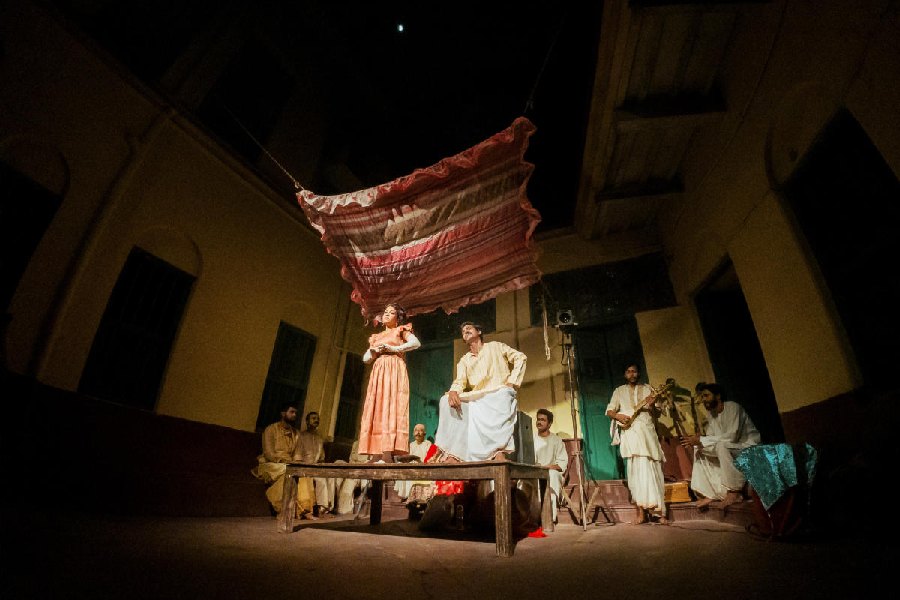Not far from Beleghata Khal Pol in north Calcutta, there is this 19th-century house. A creeper from the ground floor goes up to the overhanging wrought iron balcony. And that is where, one evening last November, some dhuti-panjabi-clad men stood confabulating. They were not residents, only actors in a play that was being staged in the nooks and crannies of this quaint house.
Barrister Babur Bari, or the house of Mr Barrister, in Beleghata has a history. It was known for the Durga Puja and Jagadhatri Puja it hosted in the late 19th century. Subhas Chandra Bose is said to have visited the house many times as did Dr Bidhan Chandra Roy, who was the family physician. Sharing these nuggets of history is the current owner of the house, who wishes to remain anonymous. She lives in the house and rents out part of it for weddings and such other occasions, which help her maintain the colonial-era property. And that is how she let Samuho, a queer-feminist theatre group and DAG (Delhi Art Gallery) use the premises for a “performance installation” inspired by Sripantha’s Keyabat Meye.

INSIDE OUTSIDE: Queer-feminist theatre group Samuho’s production of Keyabat Meye. Samuho
Sripantha is the pseudonym of the late Nikhil Sarkar, who was a social historian and writer. Keyabat Meye is the name of a Bengali farce by him. It takes its name from a 19th-century Battala erotica.
Sripantha writes: “Keya-bat meye means bravo girl. Gutsy girl. She is the heroine of modern times...” The preface runs thus: “This book is about women during colonial times. A large part of it is about 19th-century Bengali bhadramahilas. It also sheds light on the relations bet-ween men and women and the social issues prevalent during the colonial period.”
The production of Keya-bat Meye is a collection of portraits of 19th-century women. So you’d find in it Phulmoni and Rasasundari. Ten-year-old Phulmoni died after her husband Harimohon, 35, consummated their marriage. This is the same Phulmoni whose case was a catalyst to the passage of the Age of Consent Act, 1891, which raised the age of consent for sexual intercourse for all girls from 10 to 12 years. Rasasundari, married off at 12, taught herself to read and write while toiling away in the kitchen and raising eight children.
The play also has portrayals of women such as Jnanadanandini from the Tagore household and Nati Binodini, rising star of the stage.
“A friend approached me on behalf of DAG. They commissioned Samuho to do Keyabat Meye,” said Titas, dramaturge, curator, researcher and artistic director of the production. Titas, who prefers the descriptor of “a female-bodied queer theatre professional”, is an alumnus of the London International School of Performing Arts.
“Our other productions at Samuho have been in open spaces... They are driven by their clear queer-feminist point of view, content, people and how they create space. But Keyabat Meye deals with a specific period, so the house was very much part of that period,” said Titas.
The play negotiates the andarmahal and the bahirmahal, the inside and the outside worlds, and captures the reactions of people inha- biting the two spaces and their reactions to the social reforms of those times. “We needed a colonial house
because it would have to have that architecture... The outside is all about what the men are saying, what Ramesh Chandra Mitra said, what Bal Gangadhar Tilak was saying, what Raja Rammohan Roy and Vidya-sagar were saying while the andarmahal constitutes the experiences and narratives of the overlooked women,” she added.
That day, before one could realise that the play was on, a jostle and shove had begun to get inside the narrow entrance that leads to the thakurdalan or courtyard of the house. Rasabati Napitani, who is the barber, plays the sutradhar. It is the mid-1850s, and Vidyasagar has just managed to get the Widow Remarriage Act passed. In other news, Lord Bethune has floated the proposal for the first school for girls in Calcutta.
Of the 23 girls who first joined Bethune school, only nine remained. These nine girls took a giant step. They lived through the change. To date, I know of several girls who are dropping out of their PhD programmes not being able to manage home, children and studies,” said Titas, who keeps making the connection between “those times” and these times. “When Manashi Sarkar and I were writing the soliloquy of Rasasundari and how she taught herself to read and write, we cried. Had I known how Rasasundari had learnt to write, I would probably have studied more seriously,” she added.
Keyabat Meye narrates the stories of progressive women too. It makes a reference to a travelogue by Krishnabhamini Das. At one corner of Barrister Babu’s terrace, Krishnabhamini too enacts her story, her experiences, her excitement while travelling in foreign lands and how she wished that just as British women were fighting for their rights to be represented in Parliament, women in Bengal too would come out of their homes and kitchens and fight for their rights. Nati Binodini tells her story in one of the large rooms with huge mirrors and a four-poster bed.
A love story is told through letters, between Indira Devi and Pramatha Chaudhuri. Indira Devi, who was the daughter of Jnanadanandini. Why not a queer love story? Titas replied, “Queer prem did exist in those times but it was in-
visible for their safety.”











